Greetings, fellow pyromaniacs. Once again, let’s all raise a glass and toast yet another year of going out to the Black Rock Desert and doing the impossible atop the improbable with the unmentionable. It’s truly a special treat to watch a powerful community grow and form like a strong plant with many dusty winds shaping it. The roots are getting deep.
And once again we have the great pleasure to report on the smoothest and most efficient set-up and clean-up of Black Rock City yet. It’s an awesome opportunity to do a thing like this armed with the benefit of the many experiences that have formed the systems we now use and that we continue to streamline every year. And the best part is that this growth is happening for the whole community.
SURVEY
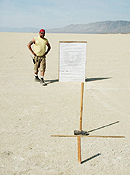 This year’s set-up started, as always, with the survey of the city on August 1, 2003. The clock design of the city grid was in its fifth year, so the survey crew was quite accustomed to the many nuances of this tricky task. Since visibility obviously plays a huge part in this process, the prime times for the work are dawn and dusk (which are truly spectacular times to be out on the playa anyway, as many know). This year, we again set a record by setting the Esplanade flags to define their warmly familiar giant arc by 8 a.m. on the first day. This arc sets the reference points for the rest of the city intersections, Center Camp, the plazas, and the fence line. This year, it also defined the four criss-cross promenades, Greeter Station, the gate and gate road, the airport, the entrance roads, walk-in camping, the DPW depot, special services, four laser towers, the Temple of Honor, and the Man itself. Over 400 individual measurements are part of the primary survey alone. With tested methods and indispensable tools like a transit, radios, laser range finders, golf carts, lengths of chain and cable, red wire survey flags, and plenty of sun block and H2O, a survey crew of eight accomplished this task in about a week, defining the city as an ocean of about 4,000 little red flags, each marking the point of yet another part of this amazing city.
This year’s set-up started, as always, with the survey of the city on August 1, 2003. The clock design of the city grid was in its fifth year, so the survey crew was quite accustomed to the many nuances of this tricky task. Since visibility obviously plays a huge part in this process, the prime times for the work are dawn and dusk (which are truly spectacular times to be out on the playa anyway, as many know). This year, we again set a record by setting the Esplanade flags to define their warmly familiar giant arc by 8 a.m. on the first day. This arc sets the reference points for the rest of the city intersections, Center Camp, the plazas, and the fence line. This year, it also defined the four criss-cross promenades, Greeter Station, the gate and gate road, the airport, the entrance roads, walk-in camping, the DPW depot, special services, four laser towers, the Temple of Honor, and the Man itself. Over 400 individual measurements are part of the primary survey alone. With tested methods and indispensable tools like a transit, radios, laser range finders, golf carts, lengths of chain and cable, red wire survey flags, and plenty of sun block and H2O, a survey crew of eight accomplished this task in about a week, defining the city as an ocean of about 4,000 little red flags, each marking the point of yet another part of this amazing city.
TRASH FENCE
Back in 1996 and 1997, we realized that our event was growing to such proportions that the time had come for us to fence off an ample chunk of playa to call our own. The fence stands from the first days of set up to the last days of clean up when all the debris and structures are off the playa. It forms a safety boundary for motor vehicles, establishes a perimeter, and catches much of the trash that blows from the city out toward the playa. The Bureau of Land Management (BLM) issues our permit with stipulations that allow no construction on the playa until two weeks before the event opens. Nothing can start until this 7.5-mile-long fence is completed, and in 2003 it went up in a record 3 days! Even the saltiest of local ranchers will give a nod of respect to this achievement. They may not care much for “art,” but they do understand the meaning of over 6,000 hand-pounded t-bar stakes and 7.5 miles of twine-tied garbage fence going up in 72 hours. It’s the donkey work, for sure.
INFRASTRUCTURE
Each year, more and more of the city’s infrastructure (Community Services, the Café, the Commissary, medical tents, community shade, etc.) gets prefabricated out at our work ranch, the Black Rock Station. Even the Man gets built there, and the more we can pre-build, the smoother the set-up goes. The set-up and tear-down are looking more and more like a circus train, with most stuff transported to the playa in steel containers the size of box cars. On move day, the flood gates open, and our transportation team kicks in to work within the a very narrow 15-day limit to transport and erect a city with a population of 30,000. Highway 34 actually does start to resemble a circus train. See DPW Transportation Report 2003. This sequence is the most exciting and hectic part of the whole DPW project, as everything has to happen at once. The fruits of planning are revealed, but things still tend to hitch up and log jam at this point. Still, it all works through in a couple of days. Communication will always be difficult on the playa, and set-up is traditionally a time to exercise patience. Clearly, increased use of shipping containers is the key to a smoother process.
Though survey and set-up were ahead of schedule, technical difficulties with the radio repeater caused serious communication problems. Radio communication is vital to safe transportation and set-up. Installation of a new repeater in the vicinity may help alleviate the situation.
As transpo ends, out come the hammers and tool-belts, and things start going up everywhere. Every structure, big and small, and all the roads and signs are installed. All the corners of the intersections and road guiding “pegs” have already been marked during the survey, so they go in systematically, but with over 160 intersections and about 2,000 peg markers, it’s like seeing the dishes stacked to the ceiling. But with enthusiasm, electrolytes and energy bars, it gets done in just a few days.
 Around August 15, all the wooden lamp posts, or “spires” start going up. They serve to define the curves of the city as well as beautifully lighting the nighttime city. This year we placed about 210 of them, 40 more than last year due to the two new lateral promenades that flowed from the Man into the 3 and 9 o’clock plazas. Setting the spires is a very labor-intensive task involving sledge hammers and screw guns. The spires themselves are pre-fabricated at the work ranch, transported, and assembled on site at the DPW depot. It takes eight people in two crews about a week to install them, and they are among the last things we take down, since they serve as reliable navigational tools. And they make for great points of reference during a dust storm, don’t cha know.
Around August 15, all the wooden lamp posts, or “spires” start going up. They serve to define the curves of the city as well as beautifully lighting the nighttime city. This year we placed about 210 of them, 40 more than last year due to the two new lateral promenades that flowed from the Man into the 3 and 9 o’clock plazas. Setting the spires is a very labor-intensive task involving sledge hammers and screw guns. The spires themselves are pre-fabricated at the work ranch, transported, and assembled on site at the DPW depot. It takes eight people in two crews about a week to install them, and they are among the last things we take down, since they serve as reliable navigational tools. And they make for great points of reference during a dust storm, don’t cha know.
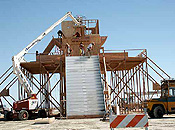 So, all in all, things went up pretty much on time and smoother than ever. One of the things that did take a lot of extra effort this year was the grand temple base upon which the Man stood. Finishing touches were still underway into Wednesday of the event week. Though the late completion allowed participants to help, which had it’s own rewards for the builders and event-goers, the crew was beyond exhausted. More planning will be focused on this job for next year to better streamline this part of the project.
So, all in all, things went up pretty much on time and smoother than ever. One of the things that did take a lot of extra effort this year was the grand temple base upon which the Man stood. Finishing touches were still underway into Wednesday of the event week. Though the late completion allowed participants to help, which had it’s own rewards for the builders and event-goers, the crew was beyond exhausted. More planning will be focused on this job for next year to better streamline this part of the project.
CLEAN UP AND SITE RESTORATION
Black Rock City is a truly unique and amazing place, as we know, and one of the characteristics that most sets it apart from all other communities is that it disappears. Its vanishing act is a key factor for the continuation of Burning Man. Any conversation with any of the locals, federal officials, neighboring ranchers, or anyone involved with Black Rock City clearly conveys the message that the respect they have for our project is founded on our own respect for the playa itself. By the first week in October, it is a real challenge to find where the Man stood and burned. This success is due to the concerted efforts of the desert rat crew that remains and the very heightened awareness of a conscientious community. Quite simply, people take out their own garbage and pick up their litter. Unique indeed!
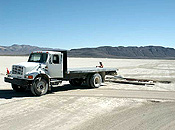 But even with this dedication from the participants, clean-up remains an enormous, month-long job. It takes about 2 weeks just to strike the structures, pack them, remove all art pieces and buildings, remove the mountains of debris and forgotten left-behinds, etc., then we have another 2 weeks of removing dunes, burn scars, spills, stains, and what-not, of course along with picking up litter, or mooping. (Moop stands for “matter out of place.”)
But even with this dedication from the participants, clean-up remains an enormous, month-long job. It takes about 2 weeks just to strike the structures, pack them, remove all art pieces and buildings, remove the mountains of debris and forgotten left-behinds, etc., then we have another 2 weeks of removing dunes, burn scars, spills, stains, and what-not, of course along with picking up litter, or mooping. (Moop stands for “matter out of place.”)
BURN SCARS
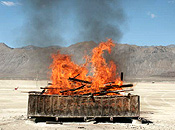 Necessity is the mother of invention! Several burns ago, some remember many frustrated clean-up crews standing around so many massive piles of jumbled ash, twisted metal, and severely charred marks on the playa surface. We have found that prevention is the key, and we have developed systems to get rid of whatever remains after participants finish burning. With designated areas for community burns, we were able to consolidate the communal burns to 18 locations around the Esplanade atop elevated metal burn platforms. The big burns such as the Man and other large-scale art burns take place on top of huge fiberglass and kevlar burn blankets covered with 3 inches of DG (decimated gravel). These layers protect the playa from the extreme temperatures and the mountains of ash and debris. The ash and gravel is scooped up with a front loader (a big tractor with a scoop on the front) and loaded into a dump truck. It winds up on the ranch, where it becomes part of a fire break. From time to time, a hot spot burns through all the protective layers and leaves a small scar. These marks are simply scraped away. The spots are then watered. All that’s needed then is a good wet winter and, in the spring, it’s back to being hard cracked playa without a trace of anything.
Necessity is the mother of invention! Several burns ago, some remember many frustrated clean-up crews standing around so many massive piles of jumbled ash, twisted metal, and severely charred marks on the playa surface. We have found that prevention is the key, and we have developed systems to get rid of whatever remains after participants finish burning. With designated areas for community burns, we were able to consolidate the communal burns to 18 locations around the Esplanade atop elevated metal burn platforms. The big burns such as the Man and other large-scale art burns take place on top of huge fiberglass and kevlar burn blankets covered with 3 inches of DG (decimated gravel). These layers protect the playa from the extreme temperatures and the mountains of ash and debris. The ash and gravel is scooped up with a front loader (a big tractor with a scoop on the front) and loaded into a dump truck. It winds up on the ranch, where it becomes part of a fire break. From time to time, a hot spot burns through all the protective layers and leaves a small scar. These marks are simply scraped away. The spots are then watered. All that’s needed then is a good wet winter and, in the spring, it’s back to being hard cracked playa without a trace of anything.
LITTER
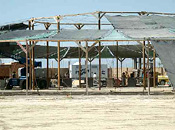 Moop is our term for litter, and it all must be picked up in order to pass a BLM inspection that occurs around the first of October. The only way to accomplish this task is to line up about 20 crew members and walk in a block-by-block pattern picking up moop. This technique is referred to as line sweeps, or as we call it the zombie walk. It’s quite a treasure hunt actually, and much of the debris tells little parts of untold stories. But mostly it’s just endless supplies of cigarette butts, wood chips, broken glass, beads, and spent fireworks. The list goes on and on, but to keep things in perspective, we actually find very little left behind from a 7-day party in the desert where 30,000 showed up. Several of the blocks swept yielded nothing at all! But the city is not without its hot spots, and the line sweeps have much to do in just 2 weeks’ time. The hot spots are where one would expect — the Man site, Center Camp, along the promenades and the Esplanade, the rave camps, the art installations, anywhere that is communal space. Yes, the line sweeps are tedious and endlessly frustrating, but they work wonders. This year’s inspection passed us by the best margins yet, and BRC continues to set the Leave No Trace standard for the many others who use the playa.
Moop is our term for litter, and it all must be picked up in order to pass a BLM inspection that occurs around the first of October. The only way to accomplish this task is to line up about 20 crew members and walk in a block-by-block pattern picking up moop. This technique is referred to as line sweeps, or as we call it the zombie walk. It’s quite a treasure hunt actually, and much of the debris tells little parts of untold stories. But mostly it’s just endless supplies of cigarette butts, wood chips, broken glass, beads, and spent fireworks. The list goes on and on, but to keep things in perspective, we actually find very little left behind from a 7-day party in the desert where 30,000 showed up. Several of the blocks swept yielded nothing at all! But the city is not without its hot spots, and the line sweeps have much to do in just 2 weeks’ time. The hot spots are where one would expect — the Man site, Center Camp, along the promenades and the Esplanade, the rave camps, the art installations, anywhere that is communal space. Yes, the line sweeps are tedious and endlessly frustrating, but they work wonders. This year’s inspection passed us by the best margins yet, and BRC continues to set the Leave No Trace standard for the many others who use the playa.
Submitted by,
Coyote
Site Manager, Black Rock City

